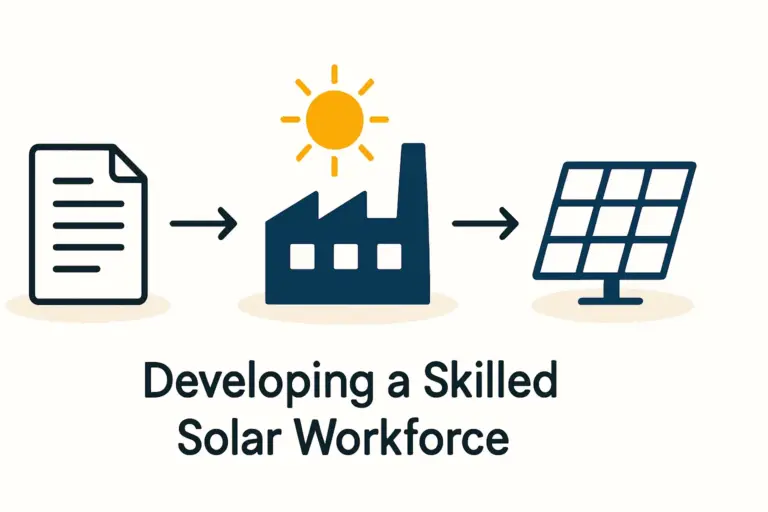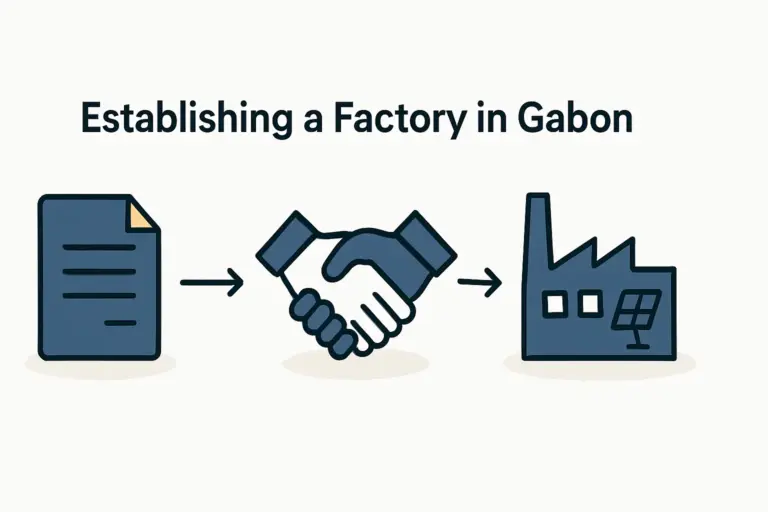An entrepreneur’s vision for a new solar module factory typically centers on state-of-the-art machinery, production targets, and market demand. In a market like Gabon, however, operational success often hinges on a less glamorous but critical factor: logistics.
The journey of a single container from a port in Asia or Europe to a factory site in Gabon is a complex undertaking demanding meticulous planning. Underestimating this phase can lead to costly delays that can derail the entire project.
This article traces the logistical pathway for importing manufacturing equipment and raw materials into Gabon—from the primary ports of entry and the customs clearance process to the significant challenges of inland transport. It also outlines key strategies for establishing a resilient supply chain.
The Gateway to Gabon: Understanding the Port Infrastructure
For any business importing goods, the journey begins at the port. Gabon’s primary maritime gateways are located near the capital, Libreville, with the Port of Owendo serving as the main hub for industrial cargo.
The New Owendo International Port (NOIP), operated by the Owendo Container Terminal (OCT), is the principal facility for containerized goods. It handles everything from the heavy machinery needed for a production line to ongoing shipments of raw materials like solar glass, cells, and aluminum frames.
Significant investment has expanded the port’s capacity to approximately 300,000 TEUs (twenty-foot equivalent units) annually. While this modernization has improved efficiency, entrepreneurs must still account for potential congestion during peak periods and build buffer time into their shipping schedules.

Understanding the port’s capabilities is the first step in mapping out the logistical chain. All subsequent planning—for customs, transport, and inventory—hinges on the processes and potential bottlenecks at this crucial point of entry.
The Critical Hurdle: Customs Clearance and Documentation
Once equipment and materials arrive at the Port of Owendo, they must clear customs, a process overseen by Gabon’s customs authority, the Direction Générale des Douanes et Droits Indirects (DGDDI). This stage is a frequent source of delays if not managed with precision.
The customs clearance process requires a complete and accurate set of documents, including:
- Bill of Lading: The official shipping receipt.
- Commercial Invoice: A detailed list of goods and their value.
- Packing List: An inventory of the contents of each container.
- Certificate of Origin: A document certifying the country where the goods were produced.
Any discrepancy or missing information can halt the process, leading to demurrage (storage) fees at the port and disrupting the project schedule. While average clearance times are often cited as 7 to 14 days, businesses would be wise to plan for a longer duration.

An effective strategy for mitigating these challenges is to operate within a Special Economic Zone (SEZ), such as the Nkok SEZ near Libreville. These zones offer a single-window clearance system that streamlines bureaucracy and can significantly accelerate the customs process. Engaging a reputable, licensed customs broker with extensive local experience is not just recommended—it’s essential for navigating these administrative complexities efficiently.
The Final Mile Challenge: Inland Transportation
After clearing customs, the cargo must be transported from the port to the factory site. In Gabon, this ‘final mile’ can be the most unpredictable and challenging part of the logistical journey.
The country’s road network is still developing, with paved roads found mostly between major cities. Routes to potential industrial sites are often unpaved and in poor condition. During Gabon’s long rainy season (typically October to May), these roads can become impassable for heavy trucks carrying sensitive manufacturing equipment—a significant business risk. A delay of several weeks due to weather is a very real possibility.

While the Trans-Gabon Railway exists, it is primarily dedicated to transporting manganese ore and offers limited utility for general container freight, leaving road transport as the only viable option for most industrial projects.
This reality makes the factory’s physical location a critical strategic decision. Siting a factory close to the Port of Owendo or inside a well-serviced SEZ like Nkok can drastically reduce transportation risks, costs, and timelines.
Building a Resilient Supply Chain for Raw Materials
Logistics planning doesn’t end once the initial factory equipment is delivered. A solar module factory requires a continuous, reliable supply of imported raw materials, making a robust and predictable logistical chain essential.
Given the potential for delays in shipping and customs, a factory in Gabon must maintain a larger inventory of critical components than a similar facility in Europe or Asia. This requires carefully calculating optimal stock levels by balancing the cost of holding inventory against the risk of a production shutdown from material shortages. This strategic calculation is a fundamental part of planning the entire manufacturing venture.
Strategic Considerations for Entrepreneurs
For an entrepreneur looking to establish a solar factory in Gabon, a successful logistics strategy is built on four pillars:
-
Strategic Location: Prioritize locations within or near the Nkok SEZ to benefit from streamlined customs and superior infrastructure. This single decision can resolve many potential logistical hurdles.
-
Expert Partnerships: Engage experienced local logistics providers and customs brokers from the outset. Their on-the-ground knowledge is invaluable and can prevent costly errors.
-
Contingency Planning: Build buffer time and contingency funds into the project budget and timeline to account for unforeseen shipping, customs, or transport delays.
-
Inventory Management: Develop a clear strategy for raw material inventory that mitigates supply chain risks without incurring excessive carrying costs.
Successfully managing these elements is a core component of setting up a turnkey solar production line, integrating logistical planning into the project from day one. Experience from J.v.G. turnkey projects shows that addressing logistics early is a key determinant of long-term success.
Frequently Asked Questions (FAQ)
What is the most common logistical mistake new investors make in Gabon?
The most frequent oversight is underestimating the complexity and potential delays of inland transportation, particularly outside of established economic zones and during the rainy season. A close second is submitting incomplete or inaccurate customs documentation.
How much time should be allocated for shipping and clearing equipment?
As a conservative estimate, businesses should plan for 30 to 60 days from the moment a ship docks at the Port of Owendo until the cargo is delivered to a factory site near Libreville. This timeframe includes potential customs delays and transport scheduling.
Is it feasible to source any solar module components locally in Gabon?
Currently, local sourcing options for high-value components like solar cells, EVA, and specialized glass are extremely limited. New ventures should plan on importing nearly 100% of their raw materials for the foreseeable future.
Does the Nkok SEZ completely eliminate logistical challenges?
The Nkok SEZ significantly simplifies and streamlines logistical processes, especially customs clearance. However, it does not eliminate the need for diligent planning of international shipping, careful coordination with freight forwarders, and strategic inventory management.
Conclusion: From Logistical Hurdles to Operational Success
Gabon’s logistical landscape presents unique challenges that demand careful preparation. For the well-prepared entrepreneur, however, these are not insurmountable barriers but manageable variables that respond to strategic planning, strong local partnerships, and a realistic project timeline.
By addressing the journey from port to production line with the same diligence given to technology and finance, a business can lay a solid foundation for a successful and resilient manufacturing operation in the heart of Central Africa. Understanding this pathway is a critical step in how to start a solar module factory in an emerging market.




